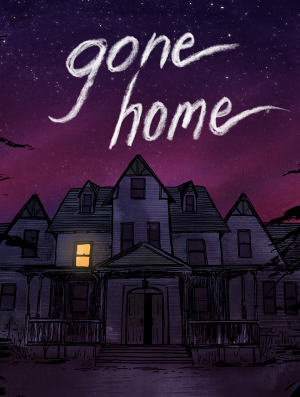Powerful Storytelling in a Confined Setting
Houses tell a story. Of the people who have or will live there and all the memories shared, every nook, every cranny, every closet, every shelf, every room, and even every piece of wood flooring contributes to the rich tapestry of a house's personal tale. The house in Fullbright's Gone Home is no exception to this, and makes for a heartwarming story of love, personal discovery, and growing up that feels as real as it is sentimental.
As Kaitlin Greenbriar, you arrive home one rainy evening in June of 1995 from your abroad studies in Europe to your family’s new house only to discover that everyone is missing. You are then tasked with the role of figuring out where everyone has disappeared to through a series of audio log-style journal entries left by your younger sister Samantha.
At first glance, your expectations of this journey might be that of a suspenseful thriller or maybe even survival horror game. At least this was the case for me. It’s all there, frankly. The imagery in the spooky cover art, the initial sense of loneliness, the gloomy aesthetic of a dark, empty, old house, and even talks of ghosts of those who once lived there. This game subverts your expectations immediately only to delight you with a powerful adventure game hook that makes you curious: If there’s nothing supernatural going on here, where is everybody?
Part of the joy of Gone Home for me was that subversion of assumption, that notion of not judging something by how it appears. Because just as the game is not how it might seem, neither is the house itself. You learn from Samantha’s journals that her new classmates are guilty of the same thing. Talks of “the new girl” who lives “at the haunted house” permeate conversation at school as you find early on in one of Samantha’s notes. Houses tell stories. People tell stories. Objects tell stories.
As a game and storytelling mechanic, progress is made through discovery of these notes. As you wander around the house, you’re welcome to pick up, touch, move, inspect, and examine almost every object within reach. That’s perhaps one of the most impressive aspects to this game is the sense of place, by allowing you to actually play in this environment without much limitation. In doing so, you’re greeted with some narration in a few key objects from Samantha, who is mainly the focus of this story. You get a sense of some personality for Kaitlin in looking at a few postcards she’s sent home, but she’s mostly a means to telling Samantha’s personal tale.
The story Samantha tells of her interactions with a new classmate is one of the most gripping and personal of any in this medium’s history. Her curiosities, struggles, and emotions are presented so perceptively that you get a sense of a real person’s story. Samantha feels like a real person. It’s human and it’s relatable.
Reinforcing such a moving story, just as importantly as the convincing voice acting and thoughtful writing, is the other goings on around the house. I mentioned sense of place before because what good is a house for a setting in this sense if it feels empty. Samantha and Kaitlin aren’t the only people who live here; they have parents, Jan and Terry Greenbriar. And frequently, you’re given insights into their lives, their struggles, their passions, or their concerns for their daughters. For example, scattered in boxes throughout the garage and study room are copies of books Terry has written over the years. You learn of his journey to become an author and his changes in publishing situations just as you learn of his rejections and persistence to keep going.
Perhaps most clever is the presentation of all these stories. As most exploration games with an audio log style aspect of story delivery, you could easily be handed the pieces to Samantha’s story in obviously placed sticky notes or pieces of paper. Instead, you’re treated to this family’s life through ordinary household items: a form sent home from school, a notebook with scribbles on the cover, or an answering machine message. You’re encouraged to explore the house in a way that respects your intelligence enough to piece everything together on your own, just as you probably would need to if you were actually Kaitlin in this context.
This style of storytelling, through a convincing environment, makes it easy to get lost in the setting you’re in. Again, this game takes place in the ‘90s, and whether you’re actually someone who grew up in this time or you’re seeing it through this lens for the first time, it’s easy to appreciate how accurate everything is presented, from the Street Fighter II cartridges, a TV guide mentioning The X-Files, or even a cassette tape in the basement of Samantha’s classmate’s band. It’s a time capsule, in a way. But it only feels that way because of how authentic everything feels.
Everything Gone Home seeks out to do is executed with precision. From the real emotion presented in its story to the creation of a living environment inhabited by seemingly real people, you’re treated with a contained story that is complex, yet simple. Complex in its layers, yet simple in its setting. The house is empty, but the family’s presence is felt in every room with ordinary objects that you just happen to discover. It’s a simple game, point and click, but you don’t play Gone Home for the gameplay. Gone Home should be played for the way it involves you in discovering the lives of believable people with stories we can relate to. There’s validation in a game like this, and games that hit this close to home don’t come around too often.
